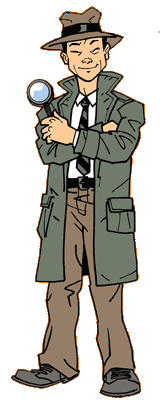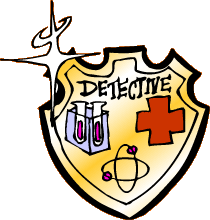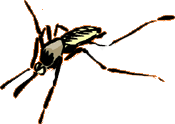DISEASE DETECTIVES
Disease Detectives
- Dr. Asthma
Meet Dr. Asthma and learn about his role at the CDC.
- Vector Victor
Meet the Vector Victor and learn about epidemiology.
Dr. Asthma
 This disease detective knows a lot about his case.
This disease detective knows a lot about his case.
Dr. Asthma spends lots of time on the phone and travelling around the country to work with other CDC groups, as well as outside organizations, on the topic of asthma. Dr. Asthma's team closely tracks the asthma cases that occur in the U.S. Their goal is to learn more about what's going on with asthma, so that they can stop the disease in its tracks. Dr. Asthma also oversees national programs to help people get their asthma under control.
Asthma: The basics.
Asthma is a breathing condition that leads to coughing, wheezing (whistling sound while breathing), trouble catching your breath, and a chest that feels tight. Even chest pains, dizziness, and always having to clear your throat can be signs of asthma, and should be checked out by a doctor.
For people with asthma, things like cold or dry air, dust, pollen, pollution, cigarette smoke, or stress can be "triggers," which cause the body to pump out chemicals that make the airways shrink, stopping air from getting through to the lungs—and causing an asthma attack. An asthma attack can feel like trying to suck air in and push it out through a straw!
Physical activity can cause asthma attacks too. Although experts aren't entirely sure why physical activity sometimes brings one on, a likely explanation is that fast breathing through the mouth (like what happens when you get winded) can irritate the airways. Dr. Asthma advises, "When smog levels are high, it's always a good idea to participate in physical activity in the morning instead of in the afternoon — smog levels rise later in the day."
Is asthma a big problem for kids today?
"About five million young people in our country have asthma," says Dr. Asthma, "When your parents were young (about 30 years ago), asthma was an uncommon disease seen in only about 3% of people. Now, it's up to at least 7%, and rising. As young kids, more boys have asthma. But some people 'grow out' of asthma (their lungs get bigger and they no longer have symptoms). As teenagers, slightly more girls have the disease."
How can kids help their friends who have asthma?
If their condition is under control, people with asthma can do the same things that you can. So, your job is to help them know that it's okay to use their inhalers or take their medicines. Also, don't worry about catching asthma 'cuz it isn't contagious.
If your friend or relative is having an asthma attack, it can be scary to watch. But according to Dr. Asthma, the first thing to do is stay calm. Encourage the person to use an inhaler (if it's on hand) and get help.
What causes asthma, anyway?
No one knows for sure yet. Dr. Asthma reports that people's genes help decide whether they develop asthma. Some researchers think that since today's young people are exposed to germs that are different than the ones that kids faced 20 or 30 years ago, their immune systems might not develop in the same way, leading to more asthma and allergies. The fact that more people than ever are overweight also might be related to increased asthma cases. (This does not mean that you should lose weight if you have asthma, though if you're overweight, it could help. Talk to your parents or your doctor to find out.) Perhaps something in the environment causes asthma... One thing is for sure — the disease detectives have leads and they're on the case!
The Vector Victor
 “I’ve been fascinated by the CDC all of my life, and I can’t believe I actually work here! It’s like being a real life disease detective.” says the Vector Victor.
“I’ve been fascinated by the CDC all of my life, and I can’t believe I actually work here! It’s like being a real life disease detective.” says the Vector Victor.
Epidemiology: The facts
 If you like mysteries, you’ll love epidemiology! Like crime scene investigators, epidemiologists begin their case crackin’ by looking for clues. They gather information about what happened—Who is sick? What are their symptoms (signs that show someone is not feeling well—headache, sore throat)? When did they get sick? Where could they have been exposed to the disease? Investigators then study the answers to these questions to find out what led to a particular health problem. Then, they use what they have learned to prevent others from getting sick.
If you like mysteries, you’ll love epidemiology! Like crime scene investigators, epidemiologists begin their case crackin’ by looking for clues. They gather information about what happened—Who is sick? What are their symptoms (signs that show someone is not feeling well—headache, sore throat)? When did they get sick? Where could they have been exposed to the disease? Investigators then study the answers to these questions to find out what led to a particular health problem. Then, they use what they have learned to prevent others from getting sick.
These real life disease detectives work in many different places—some work in laboratories where they look for viruses or bacteria in blood samples, others work in cities or towns where there are diseases, and some interview people who are sick and then try to figure out how and why they got infected.
Vector Victor studies epidemics (unusual outbreaks of diseases). Although trackin’ down diseases and crackin’ the case are the most exciting parts of Vector Victor’s job, she says that one of the most important things she does is collect background information on diseases from all across the county. These facts give the disease detectives what they need to know to figure out if an outbreak or epidemic is really happening or not, and how serious it is.
 Have you ever been called in to investigate an outbreak?
Have you ever been called in to investigate an outbreak?
Yes. One summer, Vector Victor was part of a team from the CDC that went to Louisiana to investigate an outbreak of the West Nile virus. Vector Victor and her team were invited by the Louisiana state health department to conduct a study in local hospitals and health centers to learn more about West Nile. They also hoped to crack the case of West Nile fever. The question they needed to answer: Of those people who were carrying West Nile virus, how many actually got West Nile fever? Vector Victor and her teammates were on call around the clock, and sometimes had to go into the hospital in the middle of the night to examine the patients! They collected blood samples to learn more about the West Nile virus, traced how long it stays in the patient’s body, and to find out how many people were actually sick with West Nile fever. Vector Victor and her teammates are still hard at work examining the information they gathered from 196 patients.
Vector Victor’s detective work didn’t stop there—she was also assigned to an outbreak case in Utah at Dinosaur National Monument where lots of student workers were sick. Vector Victor made a detour on her way to visit her family for a camping trip, and stopped in Utah to investigate. After spending a few days researching and examining the students, it turned out that a fungus called Valley Fever had made its way further north than it ever had before. Another case solved.
What’s a vector?
Vector Victor says that vectors are usually arthropods (animals with jointed arms and legs, a body with many sections and it’s skeleton on the outside) like ticks, fleas, mosquitoes, and other creepy crawlers. They can carry diseases from one person or animal to another—sometimes without even getting infected.
 One of Vector Victor’s biggest projects at the CDC is monitoring Lyme disease—which is carried by ticks. She says it’s an interesting trail to follow. Ticks pick up Lyme disease from mice (who don’t even get sick from the disease!), lay their eggs and travel around on deer, and sometimes end up on humans who can get sick if bitten. Vector Victor says that ticks need to be attached to a human for 1-2 days to infect them, so follow the CDC’s Tick Tactics to keep ticks away while you’re outside in areas where ticks live.
One of Vector Victor’s biggest projects at the CDC is monitoring Lyme disease—which is carried by ticks. She says it’s an interesting trail to follow. Ticks pick up Lyme disease from mice (who don’t even get sick from the disease!), lay their eggs and travel around on deer, and sometimes end up on humans who can get sick if bitten. Vector Victor says that ticks need to be attached to a human for 1-2 days to infect them, so follow the CDC’s Tick Tactics to keep ticks away while you’re outside in areas where ticks live.
What do you like most about being a real life disease detective?
Vector Victor says that the best thing about her job is that she gets to do so many different things. “One day I may work on a big project surveying diseases on a national level, and the next I might be across the country somewhere working 16 hour days on a disease outbreak. Getting to do both is so cool!”
- Page last reviewed: April 17, 2014
- Page last updated: April 17, 2014
- Content source:



 ShareCompartir
ShareCompartir